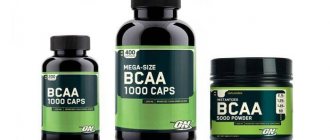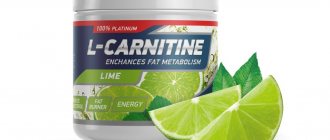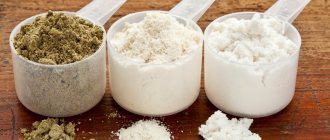Omega 3 composition
Omega-3 (Omega?3 fatty acids) are polyunsaturated fatty acids that have several double bonds in the carbon chain, starting from the third carbon atom, counting from the methyl tail of the molecule. These are, from a chemical point of view, alpha-linolenic acid (ALA), eicosapentaenoic acid (EPA) and docosahexaenoic acid (DHA). The first of them is found in large quantities in flaxseed, sea buckthorn and hemp oil, and the other two are found mainly in fish oil and some algae.
Due to their double bonds, polyunsaturated fatty acids are more biologically active - they react more easily with other substances, which makes them more easily absorbed by the body compared to the saturated fatty acids that make up animal fats. By actively participating in the conversion of cholesterol, they protect the cardiovascular system and accelerate the processing of fats, which results in faster weight loss during training.
Food biocomplexes with omega-3
Labels for lipid-containing medications most often indicate the total amount of fish oil in the capsule. However, for the treatment of functional disorders, it is important to select formulations that contain high concentrations of EPA and DHA.
Supplement Rating:
- Omega-3, Triple Strength (Solgar). The drug contains a large portion of omega-3 fatty acids extracted from the muscles of cold-water fish. The total volume of polyunsaturated lipids in the capsule is 882 milligrams (504 milligrams EPA and 378 milligrams DHA).
- Omega-800 (Madre Labs). Organic fish oil preparation is available in the form of soft gelatin capsules. The biocomplex includes: docosahexaenoic (320 milligrams) and eicosapentaenoic (480 milligrams) acids.
- Ultra Omega 3 (Now Foods). This product contains 750 milligrams of omega-3 triglycerides (500 milligrams EPA, 250 milligrams DCG). In addition, each capsule of the dietary supplement is enclosed in a special enteric coating (to prevent the appearance of an unpleasant aftertaste, belching, and nausea).
- Omega-3 (Natural Factors). Gelatin capsule contains 600 milligrams of polyunsaturated lipids (200 milligrams DHA, 400 milligrams EPA).
To maintain health, the duration of the course of taking supplements is 3–4 months. The frequency of therapy is 1 – 2 times a year.
How to take Omega 3?
The fact is that unsaturated fatty acids of the Omega-3 and Omega-6 groups are broken down in the body by the same enzymes, i.e. compete. Omega-6 acids are found in abundance in olive, sunflower and other vegetable oils, so in the diet of an ordinary person their consumption exceeds the consumption of Omega-3 acids by tens of times. The more omega-6 is consumed, the less omega-3 is absorbed, so medical standards recommend the ratio of Omega-6 to Omega-3 as 4-10 to 1. If it is impossible to eat fatty fish every day, it is useful to use such an effective drug as Omega-3 capsules. 3.
Considering the high need for polyunsaturated fatty acids for the development of children's bodies (especially the brain), many pediatricians prescribe this supplement to children aged 3 years and older. Only here it is necessary to individually calculate the dosage and take into account the likelihood of an allergic reaction. If a child is allergic to fish, then he can take Omega 3 supplements only with extreme caution, observing the manifestation of allergic reactions and refusing to take the supplement if they occur. To reduce the risk of such situations, it is better to choose not fish oil for your child, but purified Omega 3.
What is the difference between fish oil and omega-3
And here one of the most popular questions arises: what is the difference between fish oil and omega-3 acids and which is better? So, let's start with the fact that fish oil and omega-3 fatty acids are not the same thing, although many people think otherwise.
Fish oil is a product found in fish; the oil of wild marine fish is especially valuable. Omega-3 acids are a group of fatty acids that are found in fish oil. But in addition to omega-3, fish oil also contains Omega 6, Omega 9 acids, vitamins A and D and other elements. And the concentration of Omega-3 acids in fish oil, as a rule, is not as high as in Omega 3 supplements. Moreover, when buying fish oil, we do not know exactly how much omega-3 acids we need in it, and whether they are there at all . The fact is that fish oil itself can contain very few PUFAs (polyunsaturated acids), since fish also receive these substances from food (usually from algae), and what the fish eats directly affects the content of nutrients in it. fat. Nowadays, the raw material for the production of fish oil is often farmed rather than wild fish, and the fat composition of captive-bred fish leaves much to be desired, since farmers do not particularly pamper the fish with beneficial microalgae. And such fish oil, which is poor in the content of healthy fatty acids, can be packaged and put on the shelves of pharmacies and stores.
Thus, to compensate for the deficiency of these three important Omega-3 fatty acids in the body, it is better to choose the Omega-3 complex, and not the pharmaceutical fish oil that we are so familiar with from childhood.
Let's look at the comparison table to understand what is better: Omega 3 or fish oil?
| Characteristics | Fish fat | Omega-3 |
| Compound | EPA, DHA, ALA, Omega-6, Omega-9, other fatty acids, vitamins A and D, iodine - in unknown, often low, concentrations | DHA, EPA, ALA in high concentration |
| Flavor and aroma properties | pronounced fishy taste and aroma | has virtually no taste or weak taste |
| Beneficial effect | has a positive effect on vision, stomach, bones and muscles | replenishes the deficiency of three important fatty acids, has a positive effect on the functioning of the cardiovascular system, skin, brain, nervous system, gastrointestinal tract |
| Does it contain harmful components? | yes, heavy metals and toxins, with insufficient purification | No |
| Dosage | in liquid form requires a measuring spoon, leaves a smell | according to the instructions without additional accessories |
| Storage | upon contact with air, it oxidizes and loses its properties | capsules do not oxidize, are sealed |
Thus, we can see that, based on a combination of factors, omega-3 complexes are much more attractive than traditional fish oil. Omega-3s have a higher concentration of vital polyunsaturated fatty acids, while omega-6 and 9, contained in fish oil in greater quantities than omega-3, we can get from our usual food. Omega-3 complexes have a convenient dosage, a pure composition (that is, there is nothing but acids and additionally added vitamins), as well as a neutral taste and aroma.
How can an adult take Omega 3 capsules?
Omega 3 polyunsaturated fatty acids are often used for medical purposes to prevent pathologies of the cardiovascular system. By restoring the integrity of cell membranes, these substances increase the elasticity of the walls of blood vessels, reduce the amount of triglycerides in the blood, regulate cholesterol balance and reduce the amount of cholesterol deposits in the vessels, promoting their better permeability.
Omega 3s exhibit antiplatelet properties, that is (in simple terms) they slightly thin the blood, and to some extent help lower blood pressure, so people with disorders of the blood composition and circulatory functions can take them only after consultation with their doctor.
For adults, there are very few serious contraindications to taking Omega 3 supplements, except allergies, serious diseases of the liver, kidneys, gastrointestinal tract and cardiovascular system. However, before you start taking it, it is best to consult your doctor.
What restrictions may there be for taking Omega-3?
All of the above properties of fish oil really help millions of men solve health problems, but, like any drug, there are limitations.
You should avoid taking Omega-3 if you have:
- liver or kidney failure;
- excess calcium in the body;
- vitamin D hypervitaminosis;
- dysfunction of the thyroid gland;
- increased blood clotting;
- individual allergic reaction to fish oil.
Therefore, we always recommend that before you start taking Omega-3, you consult with your doctor to clarify the diagnosis and dosage, and do the necessary tests.
When is the best time to take Omega 3?
Products high in Omega 3 and special supplements will bring the greatest benefit in situations of acute shortage of these beneficial substances. This deficiency largely depends on the level of vital activity, physical and mental stress, health status, and is aggravated by hard physical work (including intense training), poor environment, and an unbalanced diet that lacks healthy fats and vitamins. All this results in a decrease in performance, frequent colds, mental depression, decreased sports motivation and deterioration in training results. To maintain active energy and maintain hormonal balance, a person includes a lot of animal fats in their food, and they create a large load on the gastrointestinal tract and cardiovascular system, leading to excess weight, accelerated aging and entail the risk of heart attack and other cardiac pathologies.
In such life situations, the benefits of taking Omega 3 supplements will be undeniable.
Omega-3: benefits and harms
Speaking about the properties of omega-3, of course, let's start by answering the question, what does omega-3 provide and what is it good for?
So, the benefits of omega-3 are as follows:
- activates the production of hormones that take part in all biochemical cellular processes
- lowers bad cholesterol levels, reducing the risk of developing cardiovascular diseases
- suppresses hunger and reduces appetite
- forms male reproductive cells, membrane membranes of neurons in the brain, as well as the retina of the eyes
- regulates the production of many hormones, including testosterone
- delivers oxygen to tissues and cells
- participates in the metabolic processes of the hormone of joy, reducing emotional stress
- maintains joint mobility, relieves pain in arthritis and arthrosis
- prevents the development of inflammatory processes
- improves attention, memory
- strengthens the body's protective properties
- helps maintain healthy hair, skin, nails
- helps prepare the body when planning pregnancy, and also helps the proper development of the fetus during pregnancy
- slows down the aging process
Omega-3 intake is beneficial for athletes because the acids:
- activate the growth of muscle tissue and reduce the volume of adipose tissue
- increase muscle tone
- prevent the production of cortisol
- increase endurance
What about the side effects of Omega-3? Overdose and oversaturation of the body with omega-3 acids carries with it a certain danger. Clinically this manifests itself as follows:
- intestinal and gastrointestinal disorders in general
- nausea and vomiting
- chest pain
- headache
- inflammatory processes
- severe blood thinning and bleeding
Of course, to achieve an excess of fatty acids in the body, you should try, but this should be kept in mind when taking a supplement. It is also impossible not to mention the contraindications to the use of omega-3:
- hypercalcemia
- allergies and individual intolerances
- thyroid disorders
- kidney and bladder stones
- age restrictions up to 7 years
- tuberculosis
Considering these nuances, you can avoid negative consequences and get the most from taking omega-3.
Dosage for women and men
Typically, the dosage of Omega 3 for daily intake is indicated from 0.5 to 1.5 g under normal conditions and 2-3 g in the case of heavy physical labor or strength training. The mechanisms of influence of Omega-3 fatty acids on metabolism are the same in men and women, so dosages are always indicated without distinguishing between genders. When encountering information that Omega-3 has a positive effect on testosterone secretion, some women fear for their hormonal profile. However, it should be noted that the effect of Omega 3 on hormone secretion is not so significant as to sharply increase testosterone levels. Unsaturated fatty acids of the Omega 3 group do not directly stimulate the synthesis of male hormones, but participate in it in the same way as all fats - they form the basis for steroid hormone molecules.
And one more consideration should relieve the fair sex from worry. The female body also needs testosterone, and it is present in it. And most importantly, testosterone is converted into estrogen (female sex hormone) by the enzyme aromatase. And if for some reason a slight increase in testosterone levels occurs in the female body, the excess will very quickly be converted into estrogen and the hormonal balance as a whole will not change.
Can I take it constantly?
There are often recommendations to regularly include Omega 3 supplements in your diet. However, to date, there is very little research on the consequences of long-term use of these supplements. The fact is that too much Omega 3 can cause some health problems, so it is safer to take the supplement in courses, taking breaks. At the same time, it is assumed that constant intake in the amount recommended by the Ministry of Health (1 g Omega 3 per day) should not cause any problems.
It is usually recommended to eat more fatty fish (tuna, salmon, herring) to maintain heart health, however, we should not forget that Omega 3 polyunsaturated fatty acids are very unstable to high temperatures and quickly oxidize. But it is important to consider that fish is almost always consumed after heat treatment; there are too few Omega 3 acids left in it to compensate for their deficiency.
Omega-3: daily dose for pregnant women
According to WHO (World Health Organization), the optimal daily intake of fish oil for expectant mothers is from 2.3 to 2.7 g. Moreover, the diet should be enriched with lipids from the first week of pregnancy. But you should not actively experiment with seafood, as they contain excessive amounts of mercury - you are allowed to eat up to 100 g of fish per day. To reduce the risk of negative effects on the fetus of certain products to zero, it is better to compensate for Omega-3 deficiency with dietary supplements, since fish oil is purified.
An increased amount of Omega-3 (up to 2-2.5 g per day) is recommended for breastfeeding women. After the baby is switched from breastfeeding to regular food, you can return to the standard acid intake.
What should you take Omega 3 with for better absorption?
Despite the chemical classification of Omega 3s as acids, they do not taste sour or bitter, rather oily and tasteless. However, they are most often supplied in capsule form. However, polyunsaturated fatty acids oxidize more quickly, especially in contact with air, when exposed to sunlight and when temperature rises. Therefore, even fish oil containing them is recommended to be consumed in capsule form rather than in liquid form, since omega-3s in a gelatin capsule are more protected from oxidation than in a bottle. In addition, among all forms of Omega 3 supplements, those that contain vitamin E (tocopherol) are preferable. Vitamin E (contained in maximum quantities in sprouted grains of wheat and corn, as well as in corn, soybean, sunflower, peanut and sea buckthorn oil) is a powerful natural antioxidant - it protects the double bonds of polyunsaturated fatty acids from destruction and thereby protects them from oxidation. Therefore, Omega-3 complexes with vitamin E are more shelf-stable. And in the body, vitamin E is responsible for the preservation of cell membranes, various proteins, enzymes, and improves reproductive function.
Omega 3 goes well with taurine and fenugreek extract - their properties to reduce the level of fatty acids in the blood are synergistic. When taken together with curcumin, an increase in anti-inflammatory effects is observed.
Omega-3: instructions for use
We conclude our review, of course, with instructions for use for men and women. How much omega-3 to drink and what is the optimal dosage of this supplement per day? Let's start in order: the daily intake of omega-3 depends on the volume of fatty acids that are part of it:
- eicosapentaenoic acid (EPA): for adults - at least 500 mg per day, for pregnant women - 800-1600 mg, for children - 200-300 mg per day
- docosahexaenoic acid (DHA): for adults, the recommended dosage of acid is 350 mg per day, for children - from 150 to 250 mg
General regimens for taking Omega-3 complexes are as follows:
- children, from 3 years: from 150 mg per day
- pregnant women: from 3000 mg per day
- children over 12 years of age and adults: from 500 mg as prescribed by a doctor, for adults the minimum dosage is at least 700 mg
| Age: | Dosage per day: | Admission rules: |
| children under 1 year | 70 mg | drops, 30 minutes before meals, once |
| children from 1 year to 3 years | 100-120 mg | |
| children from 3 to 6 years old | 150-200 mg | capsules, 30 minutes before meals, once |
| children from 6 to 12 years old | 200-250 mg | capsules, 30 minutes before meals, once |
| children from 12 to 18 years old | 500 mg | |
| adults from 18 to 50 years old | 1000-3000 mg | capsules or tablets, 30 minutes before meals, 2-3 times a day |
| during intense physical activity | 3000-5000 mg | 30 minutes before meals, 2 times a day |
| during pregnancy | 3000-5000 mg | before meals, 1-2 times a day |
What determines the number of capsules taken? There are 3 factors here:
- doctor's prescription
- body needs
- fatty acid content
Do not forget that it is important to follow the rules of administration, taking into account the compatibility of omega-3 with other vitamin complexes.
Omega-3 goes well with:
- vitamins E and K
- B vitamins (B2, B6, B12)
- Q10
- folic acid
- lecithin
Neutral interaction with:
- vitamins A, C, B
- magnesium
- selenium
Not compatible with:
- calcium
- iron
- copper
- chrome









